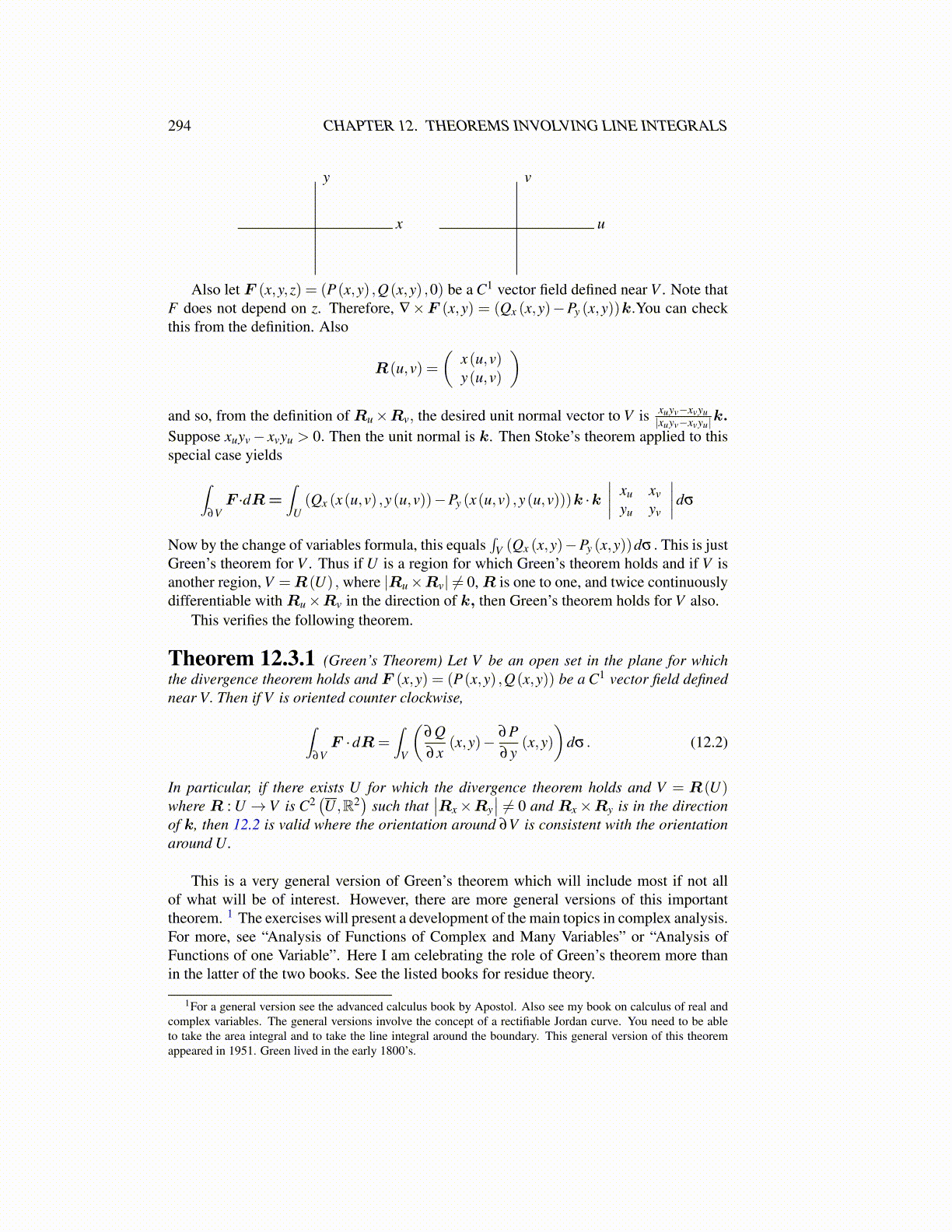
294 CHAPTER 12. THEOREMS INVOLVING LINE INTEGRALS
x
y
u
v
Also let F (x,y,z) = (P(x,y) ,Q(x,y) ,0) be a C1 vector field defined near V . Note thatF does not depend on z. Therefore, ∇×F (x,y) = (Qx (x,y)−Py (x,y))k.You can checkthis from the definition. Also
R(u,v) =(
x(u,v)y(u,v)
)and so, from the definition of Ru×Rv, the desired unit normal vector to V is xuyv−xvyu
|xuyv−xvyu|k.
Suppose xuyv− xvyu > 0. Then the unit normal is k. Then Stoke’s theorem applied to thisspecial case yields∫
∂VF ·dR=
∫U(Qx (x(u,v) ,y(u,v))−Py (x(u,v) ,y(u,v)))k ·k
∣∣∣∣ xu xvyu yv
∣∣∣∣dσ
Now by the change of variables formula, this equals∫
V (Qx (x,y)−Py (x,y))dσ . This is justGreen’s theorem for V . Thus if U is a region for which Green’s theorem holds and if V isanother region, V =R(U) , where |Ru×Rv| ̸= 0, R is one to one, and twice continuouslydifferentiable with Ru×Rv in the direction of k, then Green’s theorem holds for V also.
This verifies the following theorem.
Theorem 12.3.1 (Green’s Theorem) Let V be an open set in the plane for whichthe divergence theorem holds and F (x,y) = (P(x,y) ,Q(x,y)) be a C1 vector field definednear V. Then if V is oriented counter clockwise,∫
∂VF ·dR=
∫V
(∂Q∂x
(x,y)− ∂P∂y
(x,y))
dσ . (12.2)
In particular, if there exists U for which the divergence theorem holds and V = R(U)where R : U → V is C2
(U ,R2
)such that
∣∣Rx×Ry∣∣ ̸= 0 and Rx×Ry is in the direction
of k, then 12.2 is valid where the orientation around ∂V is consistent with the orientationaround U.
This is a very general version of Green’s theorem which will include most if not allof what will be of interest. However, there are more general versions of this importanttheorem. 1 The exercises will present a development of the main topics in complex analysis.For more, see “Analysis of Functions of Complex and Many Variables” or “Analysis ofFunctions of one Variable”. Here I am celebrating the role of Green’s theorem more thanin the latter of the two books. See the listed books for residue theory.
1For a general version see the advanced calculus book by Apostol. Also see my book on calculus of real andcomplex variables. The general versions involve the concept of a rectifiable Jordan curve. You need to be ableto take the area integral and to take the line integral around the boundary. This general version of this theoremappeared in 1951. Green lived in the early 1800’s.